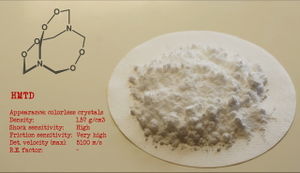Hexamethylene triperoxide diamine
 HMTD as powder
| |
| Names | |
|---|---|
| IUPAC name
3,4,8,9,12,13-Hexaoxa-1,6-diazabicyclo[4.4.4]tetradecane
| |
| Other names
1,6-diaza-3,4,8,9,12,13-hexaoxabicyclo[4.4.4]tetradecane
HMTD | |
| Properties | |
| C6H12N2O6 | |
| Molar mass | 208.17 g/mol |
| Appearance | White crystalline solid |
| Odor | Odorless |
| Density | 0.88 g/cm3 1.57 g/cm3 1.597 g/cm3 (at -123.15 °C)[1] |
| Melting point | Decomposes at 75 °C Ignites spontaneously at 133 °C |
| Boiling point | Detonates |
| 0.01 g/100 ml | |
| Solubility | Soluble in ethanol, THF |
| Solubility in acetone | 0.41 g/100 ml |
| Solubility in diethyl ether | 0.024 g/100 ml |
| Solubility in chloroform | 0.36 g/100 ml |
| Hazards | |
| Safety data sheet | None |
| Related compounds | |
| Related compounds
|
Acetone peroxide Methyl ethyl ketone peroxide |
| Except where otherwise noted, data are given for materials in their standard state (at 25 °C [77 °F], 100 kPa). | |
| Infobox references | |
Hexamethylene triperoxide diamine or HMTD is a dangerous high explosive organic compound. It has very little use outside of amateur explosives, and because it was used in many terrorist bombings, it gets a bad reputation. It was discovered by L. Legler in 1885.[2]
Contents
[hide]Properties
Chemical
Like most organic peroxides, such as acetone peroxide, HMTD is unstable and detonates when subjected to shock, friction, and heat. It is, however, less unstable than many other peroxides under normal conditions. Its sensitivity is greatly increased from exposure to ultraviolet light or in contact with most common metals. HMTD is chemically very stable when pure (free of acids, bases, and metal ions) and does not quickly sublime like its acetone counterparts.
Physical
HMTD is a white solid, which decomposes if heated to 75 °C. It has a density of 0.88 g/cm3. HMTD is soluble in THF, and somewhat soluble in ethanol.[3] It is almost insoluble in acetone, chloroform, diethyl ether and water.[4]
It is badly soluble in most solvents. Allegedly, it can be recrystallized from hot glacial acetic acid, chloroform, benzene and ethyl acetate, from which it forms rhombic plates.[5]
Explosive
HMTD is can detonate when subjected to moderate shock, friction, and heat, but it is less sensitive than most peroxide-based explosives. It has a detonation velocity of 4,511 m/s (though some sources give the value of 5,100 m/s) and a R.E. factor of 0.8, identical to that of TATP (acetone peroxide).
Availability
HMTD is not sold by any supplier due to its sensitivity.
Preparation
The preparation of HMTD always presents the risk of premature detonation and should not be attempted by amateurs. But if you really want to know:
14 g of hexamine is dissolved in 45 ml of hydrogen peroxide 30% concentration and stirred (mechanically) at 0 °C. An amount of 21 grams of finely powdered citric acid is then slowly added under continuous stirring for 3 h, at 0 °C. After 3 hours, the product is allowed to reach room temperature and left for 2 h. The white crystalline product is filtered off, and washed thoroughly with water, to remove any water soluble impurities and rinsed with methanol. The wet product is air dried. This part is risky as the product may explode during drying. The yield is around 50-70%.[6]
Larger amounts are not safe to handle, so it's best to try to make smaller amounts based on the process above.
Projects
Due to its instability, HMTD doesn't have many uses outside amateur explosives. As it is a stronger initiating explosive than mercury(II) fulminate, it can be used to make blasting caps, albeit they should be used quickly. Never use metal for these blasting caps, as this increases its sensitivity! Unfortunately, due to its use in terrorist bombings it's best to stay away from using this compound as mush as possible.
Handling
Safety
Although it is more stable than most explosive peroxides, HMTD is still sensitive to friction, shock and heat, especially when dry. Contact with metals should be avoided. If wet or underwater, it is more stable.
Legal
The manufacture, possession or use of HMTD and other organic peroxide explosives without a permit/license is a crime in most countries.
Like acetone peroxide, it is a federal offense to make, possess, or use HMTD or any other organic peroxide explosives in the United States.
Storage
NEVER STORE HMTD! Try to use it as soon as possible.
A SM user has discovered that HMTD can be safely stored at -10 °C, with no signs of any decomposition, even after 15 years.[7]
Disposal
Being a sensitive explosive, it is easy to dispose of via controlled detonation in a remote area, though this is an unsafe procedure.
Safe disposal can be done by adding a mixture of zinc sulfate, copper(II) chloride with Zn and Cu powder, in a solution containing the peroxide. The salt/metal/peroxide ratio is 5:5:1. Small amounts of sulfuric acid are also added. [8]
Gallery
References
- Jump up ↑ Wierzbicki, Andrzej; Salter, E. Alan; Cioffi, Eugene A.; Stevens, Edwin D.; Journal of Physical Chemistry A; vol. 105; nb. 38; (2001); p. 8763 - 8768
- Jump up ↑ Legler, L. (1885), Ueber Producte der langsamen Verbrennung des Aethyläthers. Ber. Dtsch. Chem. Ges., 18: 3343-3351. https://doi.org/10.1002/cber.188501802306
- Jump up ↑ http://actachemscand.org/pdf/acta_vol_42a_p0165-0170.pdf
- Jump up ↑ Haid; Globig; Z. Schiess-Sprengstoffw.; vol. 21; p. 164; Chem. Zentralbl.; vol. 98; nb. I; (1927); p. 967
- Jump up ↑ Baeyer, A. and Villiger, V. (1900), Ueber die Nomenclatur der Superoxyde und die Superoxyde der Aldehyde. Ber. Dtsch. Chem. Ges., 33: 2479-2487. https://doi.org/10.1002/cber.190003302185
- Jump up ↑ http://pubs.acs.org/doi/abs/10.1021/ja00294a043
- Jump up ↑ http://www.sciencemadness.org/talk/viewthread.php?tid=10102#pid491902
- Jump up ↑ http://energetics.chm.uri.edu/?q=/system/files/2008+Destruction+of+Peroxide+Explosives.pdf
